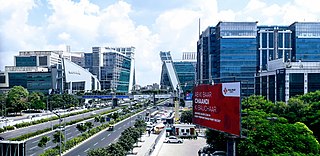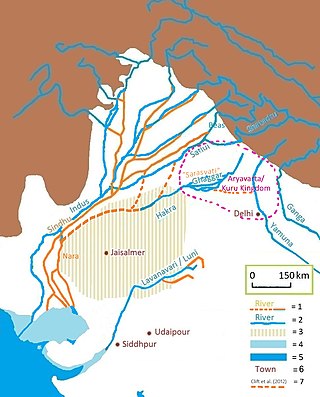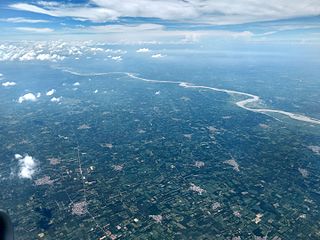
Haryana is an Indian state located in the northern part of the country. It was carved out of the former state of East Punjab on 1 Nov, 1966 on a linguistic basis. It is ranked 21st in terms of area, with less than 1.4% of India's land area. The state capital is Chandigarh, which it shares with the neighboring state of Punjab, and the most populous city is Faridabad, which is a part of the National Capital Region. The city of Gurugram is among India's largest financial and technology hubs. Haryana has 6 administrative divisions, 22 districts, 72 sub-divisions, 93 revenue tehsils, 50 sub-tehsils, 140 community development blocks, 154 cities and towns, 7,356 villages, and 6,222 villages panchayats.

The Thar Desert, also known as the Great Indian Desert, is an arid region in the north-western part of the Indian subcontinent that covers an area of 200,000 km2 (77,000 sq mi) in India and Pakistan. It is the world's 20th-largest desert, and the world's 9th-largest hot subtropical desert.

The Sarasvati River is a deified river first mentioned in the Rigveda and later in Vedic and post-Vedic texts. It played an important role in the Vedic religion, appearing in all but the fourth book of the Rigveda.

Hanumangarh is a city and municipal council in Hanumangarh district in the Indian state of Rajasthan, situated on the banks of the river Ghaggar also identified as Ancient Sarasvati river, located about 400 km from Delhi. It is the administrative headquarter of Hanumangarh District. The city was once called Bhatner because it was founded by king Bhupat in 255 AD. It remained in the control of the Rajputs of Bhati clan and faced a historic siege by Timur in 1391, during which the Bhati Raput king Dulachand lost the fort for a short time. The fort was later occupied by Rao Jetsa of Bikaner.

Fatehabad(listen)District is one of the twenty two districts of the state of Haryana, India. Fatehabad was founded by Firuz Shah Tughlaq. Fatehabad district was carved out of Hisar district on 15 July 1997.

The Ghaggar-Hakra River is an intermittent river in India and Pakistan that flows only during the monsoon season. The river is known as Ghaggar in India, before the Ottu barrage, and as the Hakra in Pakistan, downstream of the barrage, ending in the Thar Desert. In pre-Harappan times the Ghaggar was a tributary of the Sutlej. It is still connected to this paleochannel of the Sutlej, and possibly the Yamuna, which ended in the Nara River, presently a delta channel of the Indus River joining the sea via Sir Creek.
Ellenabad, previously known as Kharial, is a developing city with a municipal committee, near Sirsa City in the Sirsa district of the state of Haryana, India. It is located to the south of the Ghaggar-Hakra River and serves as a port of entry into the state of Haryana from the Rajasthan side. The Ellenabad city is divided into 17 wards for which elections are held every 5 years. As of 2011, the city had a population of 36623 in city limits and had a metro population of 44452. Ellenabad Municipal Committee has total administration over 6,810 houses to which it supplies basic amenities like water and sewerage. It is also authorize to build roads within Municipal Committee limits and impose taxes on properties coming under its jurisdiction.

Himachal Pradesh provides water to both the Indus and Ganges basins. The drainage systems of the region are the Chenab, the Ravi, the Beas, the Satluj and the Yamuna. These rivers are perennial and are fed by snow and rainfall. They are protected by an extensive cover of natural vegetation.
Tibbi is one of the seven tehsil headquarters of Hanumangarh district of Rajasthan state in India. It is at the junction of Haryana, Punjab, and Rajasthan states. The total population 8GGR Tibbi as of 2011 is 11,553.

Haryana, formed on 1 November 1966, is a state in North India. For the administrative purpose, Haryana is divided into 6 revenue divisions which are further divided into 22 districts. For Law and Order maintenance, it is divided into 5 Police Ranges and 4 Police Commissionerates.

The Ottu barrage, sometimes spelled as the Otu barrage and also known as Ottu Head, is a masonry weir on the Ghaggar-Hakra River in Sirsa, Haryana state of India that creates a large water reservoir out of the formerly-small Dhanur lake, located near the village of Ottu, which is about 8 miles from Sirsa City in Haryana, India. It is a feeder for the two Ghaggar canals that carry irrigation water to northern Haryana state. In 2002, a new tourist complex was inaugurated at the barrage, and it was given the honorary name of "Chaudhary Devi Lal Weir" to commemorate the former Chief Minister of Haryana state, Chaudhary Devi Lal. The Dhanur lake reservoir is now often referred to simply as the Ottu reservoir.
Ottu or Otu is a village under Tehsil Rania in the Sirsa district of Haryana state of India. The village is situated on Sirsa-Rania Road. It is the site of the Ottu barrage on the Ghaggar-Hakra River..

The Sahibi river, also called the Sabi River, is an ephemeral, rain-fed river flowing through Rajasthan, Haryana and Delhi states in India. It drains into Yamuna in Delhi, where its channeled course is also called the Najafgarh drain, which also serves as Najafgarh drain bird sanctuary. Sahibi is a seasonal river which is 300 km long and flows from Aravalli hills in Rajasthan to Haryana, of which 100 km is in Haryana.
Rang Mahal is a village and an ancient Kushan era archaeological site on Suratgarh-Hanumangarh road in Suratgarh tehsil of Sri Ganganagar district in the Indian state of Rajasthan. It can be reached from Hanumangarh, Pilibangan, Suratgarh. Suratgarh is the nearest major railway station to Rang mahal village.

The Bhatner fort is at Hanumangarh in Rajasthan, India, about 419 km northwest of Jaipur along the old Multan-Delhi route and 230 km north-east of Bikaner. The old name of Hanumangarh was Bhatner, which means "fortress of the Bhati". Believed to be 1700 years old, it is considered to be one of the oldest forts of India.

The Sarsuti river, originating in Sivalik Hills and flowing through the palaeochannel of Yamuna, is a tributary of Ghaggar river in of Haryana state of India. Its course is dotted with archaeological and religious sites dating back to post-Harrapan Mahabharata sites from Vedic period, such as Kapal Mochan, Kurukshetra, Thanesar, Brahma Sarovar, Jyotisar, Bhor Saidan and Pehowa.
Bagar, also Bagad (बागड़) and even Bar, a term meaning the "dry country", refers to the sandy tract of north-western India and eastern parts of current Pakistan bordering India. For example, area north and south of Ravi river between Chenab river and Sutlej is called Ihang Bar.
Western Yamuna Canal is canal in river Yamuna that was dug out and renovated in 1335 CE by Firoz Shah Tughlaq. In 1750 CE, excessive silting caused it to stop flowing. The British raj undertook a three-year renovation in 1817 by Captain GR Blane of the Bengal Engineer Group. In 1832-33 Tajewala Barrage dam at Yamuna was also built to regulate the flow of water, and later Pathrala barrage at Dadupur and Somb river dam downstream of canal were constructed in 1875-76. In 1889-95 the largest branch of the canal Sirsa branch was constructed. The modern Hathni Kund Barrage was built in 1999 to handle the problem of silting to replace the older Tajewala Barrage.

The Tangri River, also called the Dangri River, which originates in the Shivalik Hills, is a tributary of the Ghaggar River in the Haryana state of India.
The Indori river, is a rain-fed river originates from Aravalli Range from Sikar district and flows through Alwar district of Rajasthan to Rewari district of Haryana and it is the longest tributary of Sahibi River which stretches to 50 km. In Delhi, it is called the Najafgarh drain or Najafgarh Nallah.













